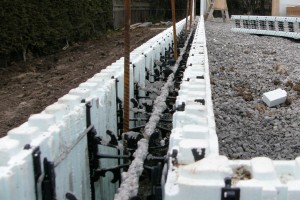
For our house, we have chosen to use insulated concrete forms (ICF) as the primary wall system for the exterior walls of the house, with sections that are structural insulated panels (SIP).
ICFs are made of 2 sheets of expanded polystyrene (EPS, aka Styrofoam) with concrete poured in between. The materials comes in blocks, and is assembled on-site in a similar fashion to Lego blocks. The blocks act as the form work for the concrete as it is poured into the cavities between the two sheets of EPS, and is a stay-in-place form work, as the blocks of EPS are not removed after the curing of the concrete. The EPS acts as the insulation for the wall, and the concrete provides the strength, and a total air and thermal break between the inside and outside of the walls.
On the inside, drywall is directly fastened to the ICF, as the ICF have built-in plastic strappings that act both as a structural component for strength and for holding the EPS together, as well as for screwing the drywall into the straps. For electrical, the EPS is thick enough to accomodate the mounting of the electrical boxes, with the wires being embedded into the EPS. No penetrations through the concrete is required, except for venting purposes.
This method of building provides a much stronger structure, which may be an advantage if you are in an natural disaster prone area. Other benefits include a much tighter building envelope, as the concrete wall system is a monolithic system and no possible penetrations for air leakage. This translates into a significant reduction of heat loss, as up to 1/2 of the heat loss of a house can be attributed to air leakage. If you live near a noisy environment, another benefit is the significant noise reduction from the outside.
In using the ICF, we decided to go from basement to the roof, except in areas on the second floor where there was nothing underneath to bear the weight of the concrete. For the basement walls, this is fairly cost competitive with traditional poured concrete walls or cement blocks. Once we went above ground, however, it becomes a significant cost upgrade to use ICF. For this reason, there are some builders that will choose to use ICF for the basement, and either traditional timber frame (cheapest) or SIPs (more expensive than traditional, less expensive than ICF) for above grade exterior walls. Expect an upcharge of $8-10/sq.ft. wall space material and labour from traditional timber frame, and an upcharge of $5-7/sq.ft. wall space from SIP, depending on complexity of project.
In our house, we have chosen to use blocks manufacturered by Nudura, supplied through our contractor for the exterior “framing” (Stevens Construction). The blocks consists of 2 5/8″ sheets of EPS on the outsides, with a 6″ cavity for the concrete. Other cavity thicknesses are available, starting at 4″ and increasing in 2″ increments.
CaGBC LEED for Homes – Points can be acheived in Energy and Atmosphere, either via the air leakage tests (EA 3.3) or exceptional energy performance (EA 1.2) via the ERS/HERS method. In our case, it would qualify for Material and Resources (MR 2.2) for local content, as the concrete and the ICF are both manufactured within 800km.

What thickness did you use on the ICF blocks 2 1/2″ on both sides or did you go thicker on the outside?
Thanks John
John,
Not much choice there, the blocks are 2 5/8″ on each side from Nudura. We went with 6″ concrete in between.
There are sections where we added an extra 1″ for the purposes of the stucco finish (where we had grooves), but otherwise we left it as is.
Looking for any info possible on a build. We plan plan to build a 2200 square foot home and want to make operating costs as low as possible. We are a young family with 2 kids and plan to be in the home for a long time so money saved over the years is an importance to me. Was planning a icf home with sips roof.
What kind of info are you looking for? Glad to offer any knowledge I’ve gathered from the build.
With these basement blocks, how do they do weeping tile with it?
The weeping tile is done the same way as a traditional build, as the ICF blocks sit on top of a traditional concrete footing, and the weeping tile is laid around the footing. Waterproofing on the ICF is done using a stick-and-peel as well as a Delta-MS, identical to a traditional build.